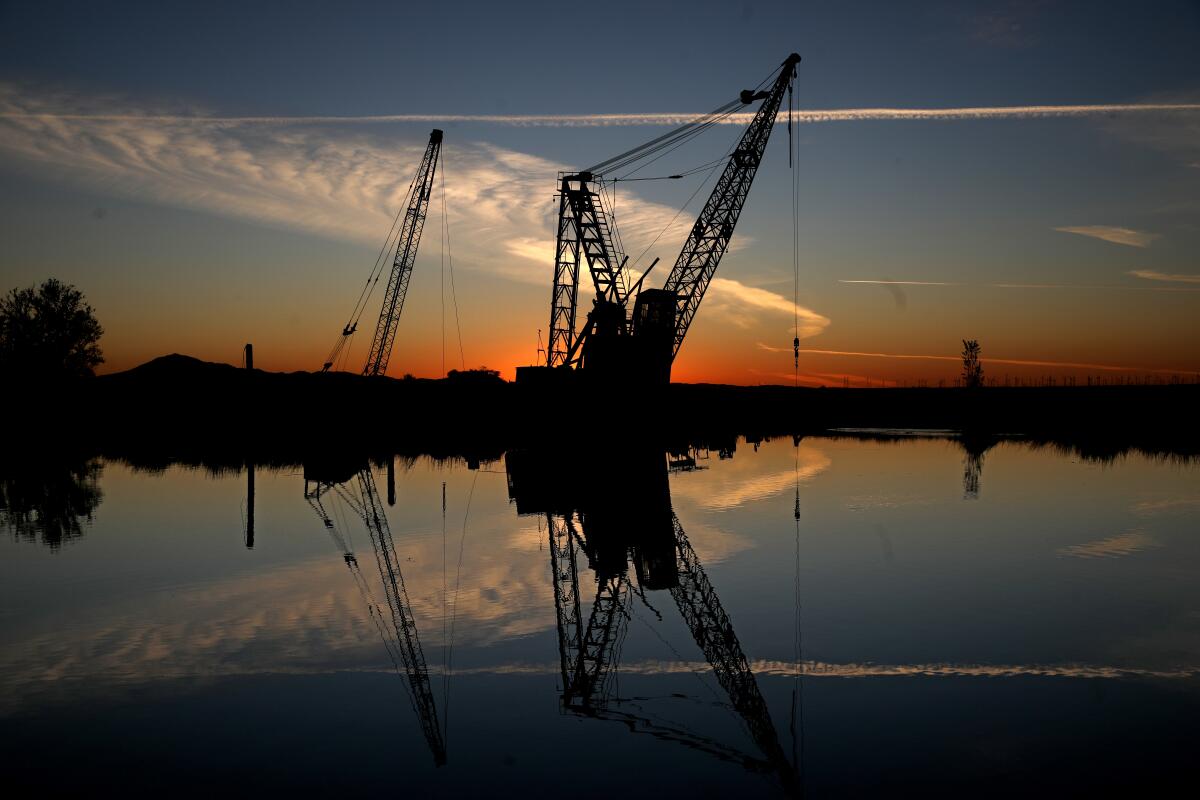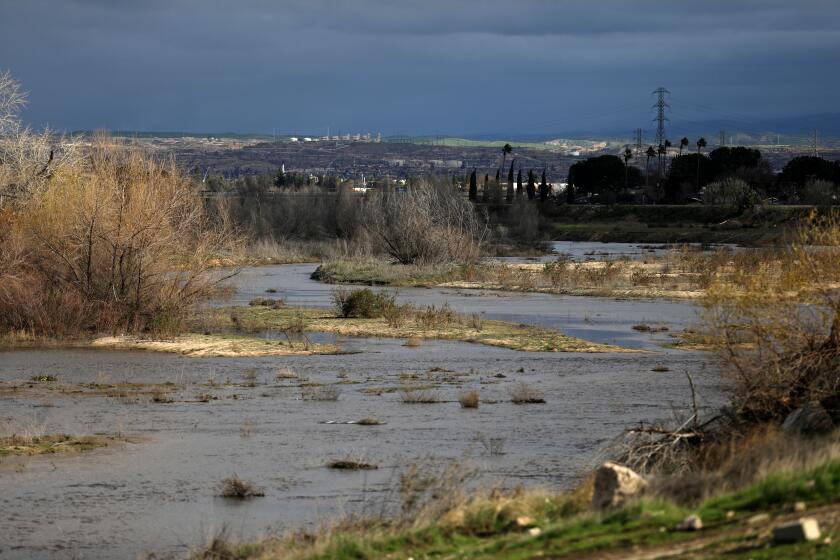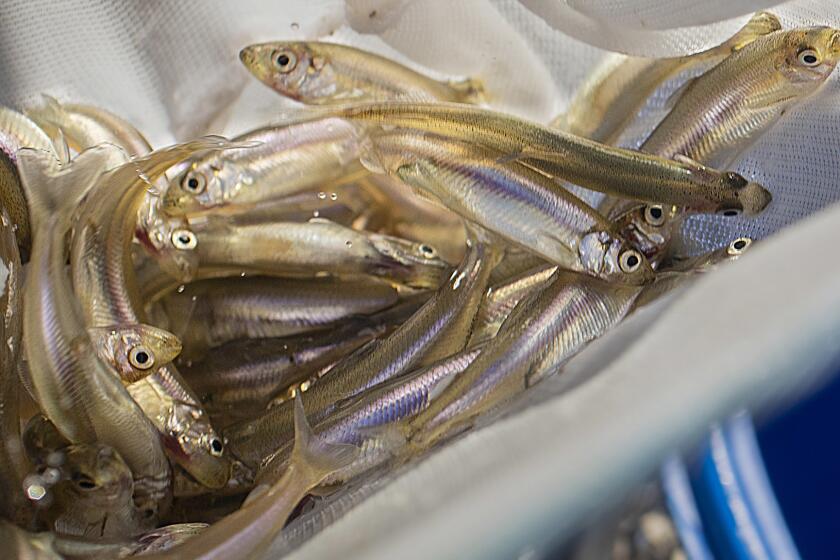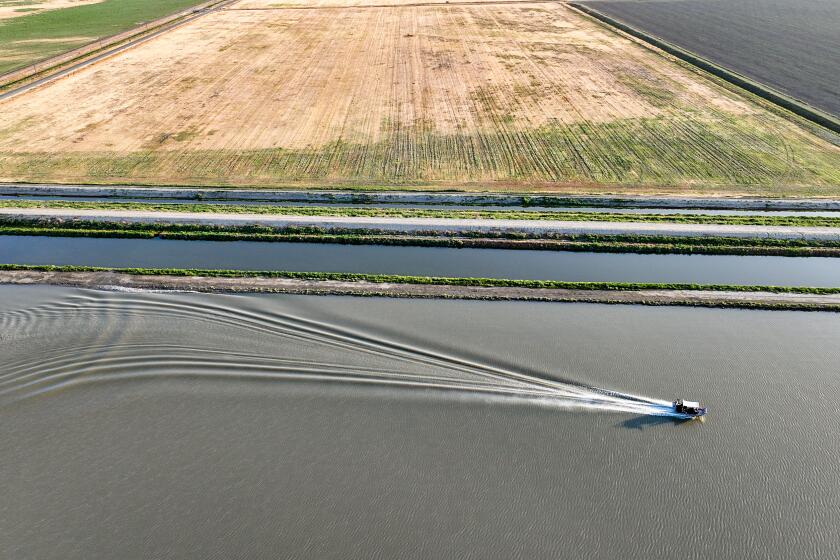Environmental rules stoke anger as California lets precious stormwater wash out to sea

Environmental rules designed to protect imperiled fish in the Sacramento-San Joaquin River Delta have ignited anger among a group of bipartisan lawmakers, who say too much of California’s stormwater is being washed out to sea instead of being pumped to reservoirs and aqueducts.
In a series of strongly worded letters, nearly a dozen legislators — many from drought-starved agriculture regions of the Central Valley —have implored state and federal officials to relax environmental pumping restrictions that are limiting the amount of water captured from the delta.
“When Mother Nature blesses us with rain, we need to save the water, instead of dumping it into the ocean,” Assemblymember Vince Fong (R-Bakersfield) wrote in a letter to Gov. Gavin Newsom.
Since the beginning of January, a series of atmospheric rivers has disgorged trillions of gallons of much-needed moisture across drought-stricken California, but only a small fraction of that water has so far made it into storage. In the delta — the heart of the state’s vast water system — nearly 95% of incoming water has flowed into the Pacific Ocean, according to data from the U.S. Bureau of Reclamation.
A series of atmospheric river storms that dropped record-breaking rain and unleashed chaos across California will end with a whimper this week.
The calls by lawmakers have reignited a long-simmering debate over where — and to whom — the state’s precious water supplies should go.
“With so much excess water in the system, there is no reason that exports south of the Delta cannot be increased,” read another letter that State Sen. Melissa Hurtado (D-Sanger) and Assemblymember Jasmeet Bains (D-Bakersfield) addressed to Newsom.
But experts say it’s not that simple.
While the delta provides drinking water for about 27 million Californians and supports the state’s massive agricultural industry, it is also a delicate ecosystem that is home to threatened and endangered species — many of which have been suffering amid warming waters, increasing salinity, dangerously low flows and other ecological stressors. The tiny delta smelt are dangerously close to extinction.
State and federal water managers said they have been complying with environmental regulations designed to protect those species, including a so-called “first flush” protocol that mandates two weeks of reduced pumping at the onset of the first big winter storms.
The flush provides the fish with enough time and water to move away from the powerful pumps, which have been known to chew them up.
“There are reasons that there are restrictions on pumping, and each of them is founded in some way, shape or form on trying to conserve habitat for listed species,” said Jeffrey Mount, a senior fellow at the Public Policy Institute of California.
Mount said it would be a mistake to ignore the environmental benefits of the water. The smelt are akin to a “canary in the coal mine” for the entire health of the delta, he said, and the first flush is biologically very important for the dynamics of the estuary.
“If we take actions which are helpful to smelt, we’ll help an array of other native fishes and the native ecosystem,” he said.
Time may be running out for California’s most infamous fish.
The first flush protocol stems from biological opinions issued by the Trump administration in 2019 and from incidental take permits issued by the Newsom administration in 2020. Some lawmakers on both sides of the aisle, however, are calling for the rules to be revised.
From Jan. 3-16, pumping rates in the delta were reduced to nearly half of their capacity in accordance with the protocol, resulting in a loss of about 84,000 acre-feet of exports from the area, according to estimates from the Public Policy Institute. That’s enough water to irrigate 25,000 acres of farmland for a year or supply 150,000 homes.
“Government regulations should not and must not deny our constituents critical water from these storms,” U.S. Rep. David Valadao (R-Hanford) and five other Republican lawmakers wrote in a letter to Newsom and President Biden last week. “We have a moral obligation to provide Californians any relief that is within our control.”

But the environment also suffers when delta water is diverted for agricultural and urban use, said Felicia Marcus, a fellow at Stanford University’s Water in the West Program.
“It’s always the fish that get shorted, and we destroyed the ecosystem as a result,” she said. “There are dry years where we’re diverting 80% to 90% of the flow during critical times of year. Well, no ecosystem survives with that kind of diversion, so we have to manage the system differently and share more of it with nature.”
She and Mount said that even with the two-week protocol, the state will still have time to capture more water. Patterns from previous wet years, including 2011, 2017 and 2019, indicate that the delta will continue to flow at high rates for at least the next few weeks. That means more time to fill the San Luis Reservoir, the delta’s key water reserve.
The reservoir, which is currently at 48% capacity, will also be filled by the state’s melting snowpack, which was at 245% of normal for the date on Thursday.
“Right now we’ve got a bonanza of snow, and it’s looking pretty good at this particular time of year, so the idea of shorting these poor fish and the ecosystem in a time of somewhat plenty isn’t very compelling,” Marcus said.
A battery of January storms has blanketed the Sierra Nevada in extraordinary snowpack, but will it last through the winter?
Still, there’s no denying that stormwater capture remains a point of frustration in California — especially as millions of residents are being asked to cut back and conserve more water than ever.
“We must make the most of the heavy precipitation we are receiving and use it to our advantage,” Rep. Jim Costa (D-Fresno) wrote in a letter to state and federal officials. He called for increased flexibility on the first flush rule.
Such flexibility would have made a difference during the recent storms, according to Jennifer Pierre, general manager of State Water Contractors, a nonprofit association of public water agencies.
Rather than tying the first flush protocol to a two-week calendar, it should be driven by real-time measurements and hydrology, she said.
“There was no off-ramp or monitoring or flexibility in either of the permits to allow us to make that call,” she said. “There’s a big lesson learned here.”
But it’s also important to be strategic about how quickly reservoirs are being filled, said Mark Gold, an adjunct professor at UCLA’s Institute of the Environment and Sustainability. Gold said it would be worrisome if the San Luis Reservoir were 100% full so early in the wet season.
“Hopefully the memory of what happened at Oroville is not lost on people’s minds,” he said, referencing the 2017 crisis in which high water levels nearly overtopped the massive Oroville Dam. “That really demonstrated how important reservoir management, volume management, really is. ... It’s not quite as simple as looking at percentages and flows.”
And while reservoir storage is important, it would behoove officials to devote more focus to groundwater recharge, or the replenishment of the state’s overdrafted aquifers, he said. Even operating at full capacity, the pumps would not have been able to capture anywhere near the amount of water that ultimately made its way to the San Francisco Bay.
“Really, maximizing replenishment in the Central Valley should be one of the highest priorities in the state of California,” Gold said.
As California is pummeled by a string of atmospheric rivers, efforts to capture and treat stormwater face many hurdles.
State officials acknowledge there are flaws in the system. In a written response to lawmakers’ concerns, Department of Water Resources director Karla Nemeth said current infrastructure to move water through the delta is “outdated, vulnerable to climate change and earthquakes, and limits the export of water during these long, sustained winter storm events.”
She said it’s an argument for a proposed $16-billion tunnel that would allow more water to be moved into state and federal aqueducts during storm events, while also protecting fish from pumps. Versions of the controversial Delta Conveyance Project have been around for decades, but the state is advancing its progress, Nemeth said.
Had it been operating during the recent storms, the tunnel would have moved about 188,000 more acre-feet of water into the San Luis Reservoir from the delta, or enough to supply nearly 2 million people for a year, according to the department.
Marcus, who formerly served as chair of the State Water Resources Control Board, said she could understand some of the frustration around the loss of water during the recent storms, but managing the state’s spigots will always require a delicate balance.
“Your job is trying to maximize all of these uses as best you can, not pick total winners and losers,” she said. “Everybody sees every drop they didn’t get as a drop that was wrongfully given to somebody else ... so that’s just part of the challenge.”
More to Read
Start your day right
Sign up for Essential California for news, features and recommendations from the L.A. Times and beyond in your inbox six days a week.
You may occasionally receive promotional content from the Los Angeles Times.











